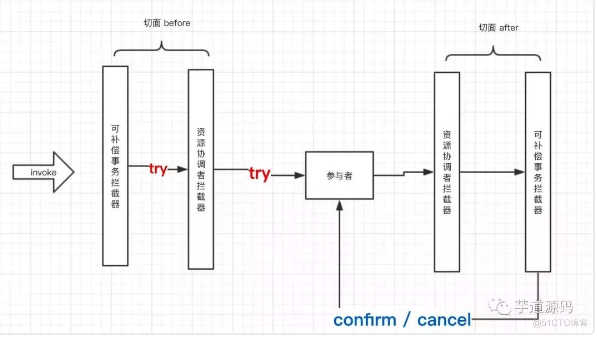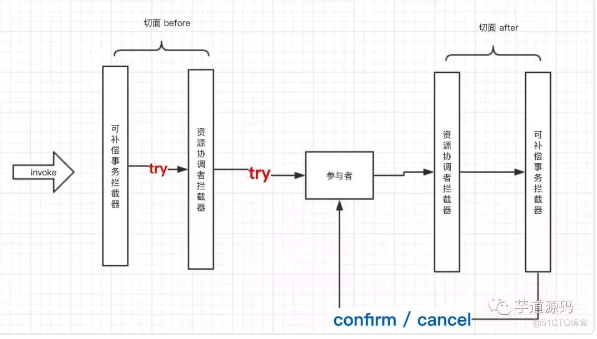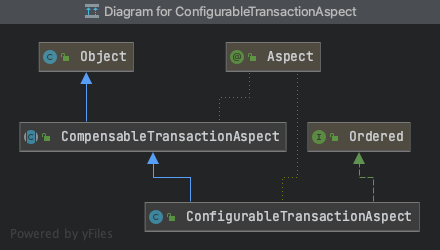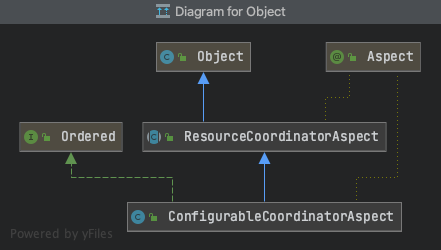三TCC-transaction分布式事务关键组件--2事务拦截器
三 TCC-transaction分布式事务关键组件--2事务拦截器
2.2.3 事务拦截器
TCC有两个拦截器:
CompensableTransactionInterceptor:可补偿事务拦截器 用于tcc事务的流程执行begin(try)、commit(confirm)、rollback(cancel) ResourceCoordinatorInterceptor:资源协调拦截器 用于记录tcc事务的Participant(参与方)

这两个拦截器,例如ResourceCoordinatorInterceptor,其基于@Compensable注解在try方法上、@Aspect注解在aspect类上作为切面类,能够拦截事务的try方法。在参与者的try方法前后是around切面逻辑,拦截器在try目标方法执行前后,分别调用两个拦截器内的方法,实现TCC事务的透明化执行过程。
@Aspect public abstract class ResourceCoordinatorAspect { private ResourceCoordinatorInterceptor resourceCoordinatorInterceptor = new ResourceCoordinatorInterceptor(); @Pointcut("@annotation(org.mengyun.tcctransaction.api.Compensable) || @annotation(org.mengyun.tcctransaction.api.EnableTcc)") public void transactionResourcePointcut() { } @Around("transactionResourcePointcut()") public Object interceptTransactionResourceMethodWithCompensableAnnotation(ProceedingJoinPoint pjp) throws Throwable { Method method = ((MethodSignature) pjp.getSignature()).getMethod(); Compensable compensable = method.getAnnotation(Compensable.class); return interceptTransactionContextMethod(new AspectJTransactionMethodJoinPoint(pjp, compensable, ThreadLocalTransactionContextEditor.class)); }
0 @Compensable注解
该注解标注在参与者的try方法上,并指定cancel/confirm方法名、事务的传播级别
@Retention(RetentionPolicy.RUNTIME) @Target({ElementType.METHOD}) public @interface Compensable { //指定事务传播级别 public Propagation propagation() default Propagation.REQUIRED; //指定cc方法 public String confirmMethod() default ""; public String cancelMethod() default ""; //是否异步执行 public boolean asyncConfirm() default false; public boolean asyncCancel() default false; }
传播级别定义:
public enum Propagation { /** * 支持当前事务,如果当前没有事务,就新建一个事务。 */ REQUIRED(0), /** * 支持当前事务,如果当前没有事务,就以非事务方式执行。 */ SUPPORTS(1), /** * 支持当前事务,如果当前没有事务,就抛出异常。 */ MANDATORY(2), /** * 新建事务,如果当前存在事务,把当前事务挂起。 */ REQUIRES_NEW(3);
1 CompensableTransactionInterceptor可补偿事务拦截器

用于tcc事务的流程执行begin(try)、commit(confirm)、rollback(cancel)

(1)CompensableTransactionAspect切面类
//配置当前类为aspect切面类(springAOP) @Aspect public abstract class CompensableTransactionAspect { //切面类内对目标方法拦截,需要调用拦截器执行具体的TCC框架逻辑 private CompensableTransactionInterceptor compensableTransactionInterceptor = new CompensableTransactionInterceptor(); //设置拦截器内的TransactionManager public void setTransactionManager(TransactionManager transactionManager) { this.compensableTransactionInterceptor.setTransactionManager(transactionManager); } //配置@Compensable标注的方法为切点 @Pointcut("@annotation(org.mengyun.tcctransaction.api.Compensable)") public void compensableTransactionPointcut() { } //在切点处,配置around环绕执行的逻辑 @Around("compensableTransactionPointcut()") public Object interceptCompensableMethod(ProceedingJoinPoint pjp) throws Throwable { //获取@Compensable注解的方法对象 Method method = ((MethodSignature) pjp.getSignature()).getMethod(); Compensable compensable = method.getAnnotation(Compensable.class); return compensableTransactionInterceptor.interceptCompensableMethod(new AspectJTransactionMethodJoinPoint(pjp, compensable, ThreadLocalTransactionContextEditor.class)); } //获取当前切面执行的优先级 public abstract int getOrder(); }
(2)ConfigurableTransactionAspect 切面配置类(执行优先级)
@Aspect public class ConfigurableTransactionAspect extends CompensableTransactionAspect implements Ordered { @Override public int getOrder() { return Ordered.HIGHEST_PRECEDENCE; //指定当前切面的优先级 } @Autowired public void setTransactionManager(TransactionManagerFactory transactionManagerFactory) { super.setTransactionManager(transactionManagerFactory.getTransactionManager()); } }
当前切面配置类,主要是实现orderde接口,定义切面的优先级Ordered.HIGHEST_PRECEDENCE(ResourceCoordinatorInterceptor配置的优先级为Ordered.HIGHEST_PRECEDENCE+1,所以执行时,位于后面,先执行CompensableTransactionAspect)
(3)CompensableTransactionInterceptor拦截器
public class CompensableTransactionInterceptor { //拦截器中持有transactionManager private TransactionManager transactionManager; public void setTransactionManager(TransactionManager transactionManager) { this.transactionManager = transactionManager; } public Object interceptCompensableMethod(TransactionMethodJoinPoint pjp) throws Throwable { //获取当前transactionManager的本地线程变量上事务队列的首部transaction Transaction transaction = transactionManager.getCurrentTransaction(); //创建可补偿方法执行上下文对象 CompensableMethodContext compensableMethodContext = new CompensableMethodContext(pjp, transaction); //如果方法被@Compensable注解&transaction context为null&transaction对象为null,那么ParticipantRole为ROOT根角色 //如果方法被@Compensable注解&transaction context存在&transaction对象为null,那么表示已经创建transaction context事务上下文,此时ParticipantRole的为privider提供者角色 //TAG1 compensableMethodContext.getParticipantRole() switch (compensableMethodContext.getParticipantRole()) { case ROOT: //执行root根事务方法 //TAG2 rootMethodProceed return rootMethodProceed(compensableMethodContext); case PROVIDER: //执行provider提供者事务方法 //TAG3 providerMethodProceed return providerMethodProceed(compensableMethodContext); default: //默认不处理,继续目标方法try的执行 return compensableMethodContext.proceed(); } }
这里,CompensableTransactionInterceptor拦截器,在被@Compensable标注的try方法执行时,通过切面类拦截,然后调用此处拦截器方法:
1 获取当前transactionManager的本地线程变量上事务队列的首部transaction; 2 创建CompensableMethodContext; 3 根据TCC方法上下文,判断当前参与者的角色,是ROOT(事务发起者)还是PROVIDER(分支事务的参与者)------根据不同参与者类型,执行不同的事务处理
TAG1 compensableMethodContext.getParticipantRole()
该方法,是通过transactionContext、compensable、transaction三个对象的存在情况,判断当前参与者的角色--是ROOT发起根事务的角色、还是PRIVIDER分支事务参与者的角色。
判断参与者角色是ROOT还是PROVIDER原则:
//如果方法被@Compensable注解&transaction context为null&transaction对象为null,那么ParticipantRole为ROOT根角色 //如果方法被@Compensable注解&transaction context存在&transaction对象为null,那么表示已经创建transaction context事务上下文,此时ParticipantRole的为privider提供者角色
public class CompensableMethodContext { //事务方法连结点(具体详看spring部分) TransactionMethodJoinPoint pjp = null; TransactionContext transactionContext = null; Compensable compensable = null; private Transaction transaction = null; public ParticipantRole getParticipantRole() { // 1 如果方法是@Compensable注释的,则表示需要tcc事务,如果没有活动事务,则需要require new。 // 2 If方法没有@Compensable注解,但TransactionContext存在: //2.1如果有活动事务,则表示需要参与者tcc事务。如果transactionContext为空,那么它将事务登记为CONSUMER角色; // 2.2 如果没有活动事务activeTransaction,表示有另一个方法被调用,因为Consumer已经登记为了事务,这个方法不需要登记为参与者。 //如果方法被@Compensable注解&transaction context为null&transaction对象为null,那么ParticipantRole为ROOT根角色 if (compensable != null && transaction == null && transactionContext == null) { return ParticipantRole.ROOT; } //如果方法被@Compensable注解&transaction context存在&transaction对象为null,那么表示已经创建transaction context事务上下文,此时ParticipantRole的为privider提供者角色 if (compensable != null && transaction == null && transactionContext != null) { return ParticipantRole.PROVIDER; } //不进行事务处理 return ParticipantRole.NORMAL; } public Object proceed() throws Throwable { return this.pjp.proceed(); }
TAG2 rootMethodProceed发起TCC流程
当ParticipantRole为ROOT时,发起根事务,开启TCC流程:
private Object rootMethodProceed(CompensableMethodContext compensableMethodContext) throws Throwable { Object returnValue = null; //事务对象 Transaction transaction = null; //是否异步执行confirm/cancel boolean asyncConfirm = compensableMethodContext.getAnnotation().asyncConfirm(); boolean asyncCancel = compensableMethodContext.getAnnotation().asyncCancel(); try { //发起根root事务 transaction = transactionManager.begin(compensableMethodContext.getUniqueIdentity()); try { //执行方法原逻辑,即try逻辑 returnValue = compensableMethodContext.proceed(); } catch (Throwable tryingException) { try { //当原逻辑执行失败时,即try阶段失败---回滚 transactionManager.rollback(asyncCancel); } catch (Exception rollbackException) { logger.warn("compensable transaction rollback failed, recovery job will try to rollback later", rollbackException); } throw tryingException; } //当原逻辑执行成功时,即try阶段成功,提交事务 transactionManager.commit(asyncConfirm); } finally { //将事物从当前线程事务队列移除 transactionManager.cleanAfterCompletion(transaction); } return returnValue; }
主要逻辑:
1 transactionManager.begin发起根事务; 2 compensableMethodContext.proceed()执行try; 2.1 如果try失败抛异常,transactionManager.rollback(asyncCancel)回滚 3 transactionManager.commit(asyncConfirm) try执行成功,commit提交事务; 4 transactionManager.cleanAfterCompletion(transaction)将transaction从事务管理器transactionManager的本地线程变量的事务队列中移除; 5 返回结果;
TAG3 providerMethodProceed服务提供者参与TCC流程
当参与者角色为PROVIDER时,执行该方法:(ROOT是发起事务,在TCC三个阶段开始前,所以不需要通过compensableMethodContext.getTransactionContext().getStatus()判断当前所处的阶段;但是PROVIDER角色时,参与者参与事务,因此需要知道自己当前处于当前事务的哪个阶段执行过程TRYING、CONFIRMING、CANCELLING。
private Object providerMethodProceed(CompensableMethodContext compensableMethodContext) throws Throwable { Transaction transaction = null; //是否异步执行cc boolean asyncConfirm = compensableMethodContext.getAnnotation().asyncConfirm(); boolean asyncCancel = compensableMethodContext.getAnnotation().asyncCancel(); try { //获取TransactionContext().getStatus()中,当前TCC执行的阶段 switch (compensableMethodContext.getTransactionContext().getStatus()) { /** ……………………………………………………………………………………………………TRYING………………………………………………………………………………………………………………*/ case TRYING: //如果trying阶段,需要propagationNewBegin传播并发起分支事务(包括创建transaction、存储、注册) transaction = transactionManager.propagationNewBegin(compensableMethodContext.getTransactionContext()); Object result = null; try { //执行原try逻辑 result = compensableMethodContext.proceed(); //设置transactionManager上事务队列首个事务状态TRY_SUCCESS,并在数据库中更新 transactionManager.changeStatus(TransactionStatus.TRY_SUCCESS); } catch (Throwable e) { try { //如果try执行失败,设置transactionManager上事务队列首个事务状态为TRY_FAILED,并更新数据库中数据 transactionManager.changeStatus(TransactionStatus.TRY_FAILED); } catch (Exception ignore) { //ignore } throw e; } return result; /** ……………………………………………………………………………………………………CONFIRMING………………………………………………………………………………………………………………*/ case CONFIRMING: try { //获取传播分支事务 transaction = transactionManager.propagationExistBegin(compensableMethodContext.getTransactionContext()); //执行提交 transactionManager.commit(asyncConfirm); } catch (NoExistedTransactionException excepton) { //the transaction has been commit,ignore it. logger.warn("no existed transaction found at CONFIRMING stage, will ignore and confirm automatically. transaction xid:{}", compensableMethodContext.getTransactionContext().getXid()); } break; /** ……………………………………………………………………………………………………CANCELLING………………………………………………………………………………………………………………*/ case CANCELLING: try { //从消费者端传递过来的,分支事务branch的状态status ParticipantStatus transactionStatusFromConsumer = compensableMethodContext.getTransactionContext().getParticipantStatus(); //获取传播分支事务 transaction = transactionManager.propagationExistBegin(compensableMethodContext.getTransactionContext()); // 1 只有transaction's status 处于TRY_SUCCESS、TRY_FAILED、CANCELLING stage,才能rollback(表示第一阶段的try执行结束,所以,单纯的trying状态,是不能够rollback的) // 2 如果 transactionStatusFromConsumer 是TRY_SUCCESS,也表示第一阶段try执行结束, 无论当前transaction的状态是否是trying,都可以rollback // (原因:transaction's status is TRYING while transactionStatusFromConsumer is TRY_SUCCESS 可能会发生的,就是当 transaction's changeStatus 是异步执行时.) if (transaction.getStatus().equals(TransactionStatus.TRY_SUCCESS) || transaction.getStatus().equals(TransactionStatus.TRY_FAILED) || transaction.getStatus().equals(TransactionStatus.CANCELLING) || ParticipantStatus.TRY_SUCCESS.equals(transactionStatusFromConsumer)) { transactionManager.rollback(asyncCancel); } else { //in this case, transaction's Status is TRYING and transactionStatusFromConsumer is TRY_FAILED // this may happen if timeout exception throws during rpc call. throw new IllegalTransactionStatusException("Branch transaction status is TRYING, cannot rollback directly, waiting for recovery job to rollback."); } } catch (NoExistedTransactionException exception) { //the transaction has been rollback,ignore it. logger.info("no existed transaction found at CANCELLING stage, will ignore and cancel automatically. transaction xid:{}", compensableMethodContext.getTransactionContext().getXid()); } break; } } finally { //清理当前事务对象 transactionManager.cleanAfterCompletion(transaction); } Method method = compensableMethodContext.getMethod(); return ReflectionUtils.getNullValue(method.getReturnType()); }
对于服务提供者provider,在事务执行过程的逻辑如下:
switch (compensableMethodContext.getTransactionContext().getStatus()) { TRYING: 1 propagationNewBegin传播并发起分支事务------该方法调用前提:TransactionStatus.TRYING&ParticipantRole.PROVIDER; 2 compensableMethodContext.proceed()执行try方法逻辑; 3 transactionManager.changeStatus(TransactionStatus.TRY_SUCCESS) try成功,修改transaction状态,并update持久存储内; 2.1 如果try失败,transactionManager.changeStatus(TransactionStatus.TRY_FAILED),修改transaction状态,并update; 4 return; CONFIRMING: 1 propagationExistBegin传播并获取分支事务------该方法调用前提:TransactionStatus.CONFIRMING&ParticipantRole.PROVIDER; 2 transactionManager.commit(asyncConfirm)提交; (confirm失败的逻辑,在transactionManager中,会update更新transaction) CANCELLING: 1 propagationExistBegin传播并获取分支事务------该方法调用前提:TransactionStatus.CANCELLING&ParticipantRole.PROVIDER; 2 可以执行rollback的条件和情况如下: // 1 只有transaction's status 处于TRY_SUCCESS、TRY_FAILED、CANCELLING stage,才能rollback(表示第一阶段的try执行结束,所以,单纯的trying状态,是不能够rollback的) // 2 如果 transactionStatusFromConsumer 是TRY_SUCCESS,也表示第一阶段try执行结束, 无论当前transaction的状态是否是trying,都可以rollback // (原因:transaction's status is TRYING while transactionStatusFromConsumer is TRY_SUCCESS 可能会发生的,就是当 transaction's changeStatus 是异步执行时.) finally{ transactionManager.cleanAfterCompletion(transaction);清理事务 }
2 ResourceCoordinatorInterceptor资源协调拦截器

用于记录tcc事务的Participant(参与方),ResourceCoordinatorInterceptor只在try阶段使用,负责participant的创建、添加入transaction、pjp.proceed执行try方法、根据try执行是否成功设置participant的执行状态。负责参与者的管理。

(1)ResourceCoordinatorAspect 切面类
@Aspect public abstract class ResourceCoordinatorAspect { private ResourceCoordinatorInterceptor resourceCoordinatorInterceptor = new ResourceCoordinatorInterceptor(); @Pointcut("@annotation(org.mengyun.tcctransaction.api.Compensable) || @annotation(org.mengyun.tcctransaction.api.EnableTcc)") public void transactionResourcePointcut() { } @Around("transactionResourcePointcut()") public Object interceptTransactionResourceMethodWithCompensableAnnotation(ProceedingJoinPoint pjp) throws Throwable { Method method = ((MethodSignature) pjp.getSignature()).getMethod(); Compensable compensable = method.getAnnotation(Compensable.class); return interceptTransactionContextMethod(new AspectJTransactionMethodJoinPoint(pjp, compensable, ThreadLocalTransactionContextEditor.class)); } public Object interceptTransactionContextMethod(TransactionMethodJoinPoint pjp) throws Throwable { return resourceCoordinatorInterceptor.interceptTransactionContextMethod(pjp); } public void setTransactionManager(TransactionManager transactionManager) { this.resourceCoordinatorInterceptor.setTransactionManager(transactionManager); } public abstract int getOrder(); }
具体分析和可补偿事务拦截器相同,省略。
(2)ConfigurableCoordinatorAspect切面配置类(执行优先级)
@Aspect public class ConfigurableCoordinatorAspect extends ResourceCoordinatorAspect implements Ordered { @Override public int getOrder() { return Ordered.HIGHEST_PRECEDENCE + 1; } @Autowired public void setTransactionManager(TransactionManagerFactory transactionManagerFactory) { super.setTransactionManager(transactionManagerFactory.getTransactionManager()); } }
切面优先级为Ordered.HIGHEST_PRECEDENCE + 1,其在可补偿事务拦截器切面后执行。
(3)ResourceCoordinatorInterceptor资源协调拦截器
这个拦截器两个作用:
1 负责participant参与者对象的创建(条件:事务transaction对象不为null&&transaction.getStatus()事务状态为TRYING),然后将participant加入transaction的list中,并update入持久化存储;
2 并在try执行过程中,如果执行成功,设置ParticipantStatus.TRY_SUCCESS;如果失败,ParticipantStatus.TRY_FAILED。
总结:
ResourceCoordinatorInterceptor只在try阶段使用,负责participant的创建、添加入transaction、pjp.proceed执行try方法、根据try执行是否成功设置participant的执行状态。负责参与者的管理。
public class ResourceCoordinatorInterceptor { private TransactionManager transactionManager; public void setTransactionManager(TransactionManager transactionManager) { this.transactionManager = transactionManager; } public Object interceptTransactionContextMethod(TransactionMethodJoinPoint pjp) throws Throwable { Transaction transaction = transactionManager.getCurrentTransaction(); if (transaction != null && transaction.getStatus().equals(TransactionStatus.TRYING)) { //1 //当事务状态为trying时,添加事务参与者 Participant participant = enlistParticipant(pjp); Object result = null; //创建TransactionStatus.TRYING, ParticipantStatus.TRYING两个状态的事务上下文TransactionContext TransactionContext transactionContext = new TransactionContext(transaction.getRootDomain(), transaction.getRootXid(), participant.getXid(), TransactionStatus.TRYING, ParticipantStatus.TRYING); FactoryBuilder.factoryOf(participant.getTransactionContextEditorClass()).getInstance().set(transactionContext, pjp.getTarget(), pjp.getMethod(), pjp.getArgs()); try { //执行try方法原逻辑 result = pjp.proceed(pjp.getArgs()); //如果执行成功,设置参与者participantStatus为TRY_SUCCESS participant.setStatus(ParticipantStatus.TRY_SUCCESS); } catch (Throwable e) { participant.setStatus(ParticipantStatus.TRY_FAILED); //if root transaction, here no need persistent transaction // because following stage is rollback, transaction's status is changed to CANCELING and save // transactionManager.update(participant); throw e; } finally { FactoryBuilder.factoryOf(participant.getTransactionContextEditorClass()).getInstance().clear(transactionContext, pjp.getTarget(), pjp.getMethod(), pjp.getArgs()); } return result; } //1 //如果不需要加入participant对象到transaction,那么执行方法原逻辑(即拦截器链,继续向下执行,try方法) return pjp.proceed(pjp.getArgs()); } private Participant enlistParticipant(TransactionMethodJoinPoint pjp) { Transaction transaction = transactionManager.getCurrentTransaction(); CompensableMethodContext compensableMethodContext = new CompensableMethodContext(pjp, transaction); String confirmMethodName = compensableMethodContext.getConfirmMethodName(); String cancelMethodName = compensableMethodContext.getCancelMethodName(); Class<? extends TransactionContextEditor> transactionContextEditorClass = compensableMethodContext.getTransactionContextEditorClass(); TransactionXid xid = TransactionXid.withUniqueIdentity(null); Class targetClass = compensableMethodContext.getDeclaredClass(); InvocationContext invocationContext = new InvocationContext(targetClass, confirmMethodName, cancelMethodName, compensableMethodContext.getMethod().getParameterTypes(), compensableMethodContext.getArgs()); //构造参与者Participant Participant participant = new Participant( transaction.getRootDomain(), transaction.getRootXid(), xid, invocationContext, transactionContextEditorClass); //将participant加入transactionManager的当前transaction的list<Participant>中,然后update transactionManager.enlistParticipant(participant); return participant; } }






【推荐】国内首个AI IDE,深度理解中文开发场景,立即下载体验Trae
【推荐】编程新体验,更懂你的AI,立即体验豆包MarsCode编程助手
【推荐】抖音旗下AI助手豆包,你的智能百科全书,全免费不限次数
【推荐】轻量又高性能的 SSH 工具 IShell:AI 加持,快人一步
· 10年+ .NET Coder 心语,封装的思维:从隐藏、稳定开始理解其本质意义
· .NET Core 中如何实现缓存的预热?
· 从 HTTP 原因短语缺失研究 HTTP/2 和 HTTP/3 的设计差异
· AI与.NET技术实操系列:向量存储与相似性搜索在 .NET 中的实现
· 基于Microsoft.Extensions.AI核心库实现RAG应用
· TypeScript + Deepseek 打造卜卦网站:技术与玄学的结合
· 阿里巴巴 QwQ-32B真的超越了 DeepSeek R-1吗?
· 【译】Visual Studio 中新的强大生产力特性
· 10年+ .NET Coder 心语 ── 封装的思维:从隐藏、稳定开始理解其本质意义
· 【设计模式】告别冗长if-else语句:使用策略模式优化代码结构